How to Plant Passion Fruit: Easy Steps for Beginners
- February 29, 2024
- 0 comment
Passion fruit, known scientifically as Passiflora edulis, is a vigorous vine known for its beautiful flowers and delicious fruit. Originating from South America, it’s now grown in various tropical and subtropical regions worldwide. This guide will provide you with step-by-step instructions on planting and caring for your passion fruit vine, ensuring a bountiful harvest.
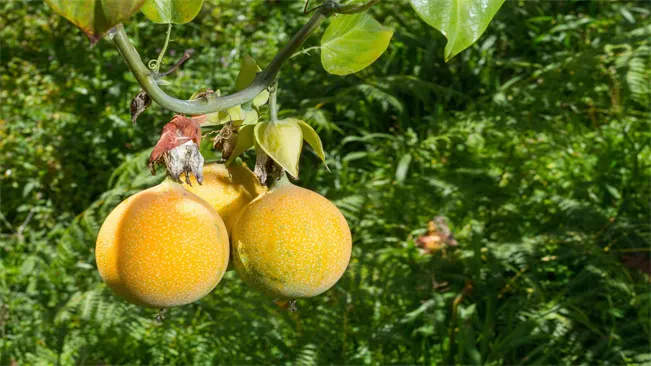
Nutritional Benefits of Passion Fruit
| Benefit | Description |
|---|---|
| Nutrient-Rich | Passion fruit is a rich source of vitamins A and C, dietary fiber, and essential minerals like potassium and iron. |
| High in Antioxidants | Contains powerful antioxidants like vitamin C, beta carotene, and polyphenols, which help reduce oxidative stress and inflammation in the body. |
| Supports Heart Health | The high fiber content can help in reducing cholesterol levels in the blood, promoting heart health. |
| Boosts Immune System | Vitamin C and other antioxidants in passion fruit strengthen the immune system and help in fighting infections. |
| Aids Digestive Health | The dietary fiber in passion fruit aids in digestion and can help prevent constipation and maintain a healthy gut. |
| Improves Insulin Sensitivity | May improve insulin sensitivity in people with type 2 diabetes, helping in blood sugar control. |
| Good for Eye Health | Vitamin A and flavonoids present in passion fruit are beneficial for eye health and can help in preventing age-related macular degeneration. |
| Rich in Iron | Iron is essential for hemoglobin formation and improving blood circulation, making passion fruit beneficial in preventing anemia. |
| Low Glycemic Index | Its low glycemic index makes it a favorable fruit for maintaining steady blood sugar levels. |
| Calming Effects | Some studies suggest that passion fruit has mild sedative properties, which can help in reducing anxiety and improving sleep quality. |
List on How To Plant Passion Fruit
- Choosing the Right Variety
- Site Selection and Soil Preparation
- Planting
- Watering and Fertilization
- Pruning and Training
- Harvesting
- Pest and Disease Management
Choosing the Right Variety
There are two main types of passion fruit – the purple variety (Passiflora edulis) and the yellow variety (Passiflora edulis flavicarpa). The purple variety is more suited to cooler climates, while the yellow thrives in warmer areas. Choose a variety that is best suited to your local climate.
Purple Passion Fruit (Passiflora edulis)
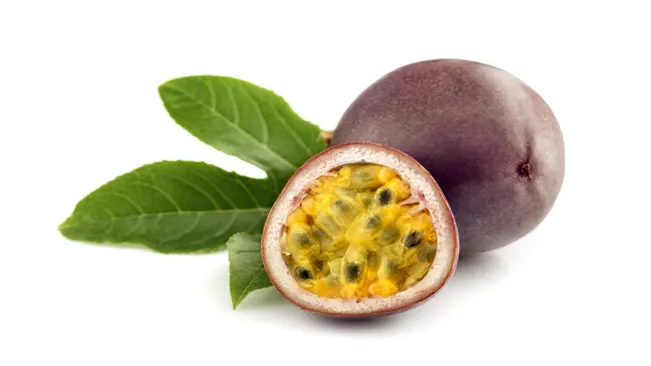
- Climate Suitability: Better suited for cooler, subtropical climates. It can tolerate mild frosts and cooler temperatures better than its yellow counterpart. Ideal growing temperatures range from 68°F to 82°F (20°C to 28°C).
- Fruit Characteristics: The purple passion fruit is smaller and generally sweeter than the yellow variety. The skin is deep purple when ripe, and the pulp is aromatic with a rich, sweet-tart flavor.
- Growing Conditions: Requires well-drained soil and moderate humidity. While it tolerates cooler temperatures, it still needs a good amount of sunlight.
- Usage: Often eaten fresh or used in juices, desserts, and sauces. Its sweet flavor makes it more popular for direct consumption.
Yellow Passion Fruit (Passiflora edulis flavicarpa)
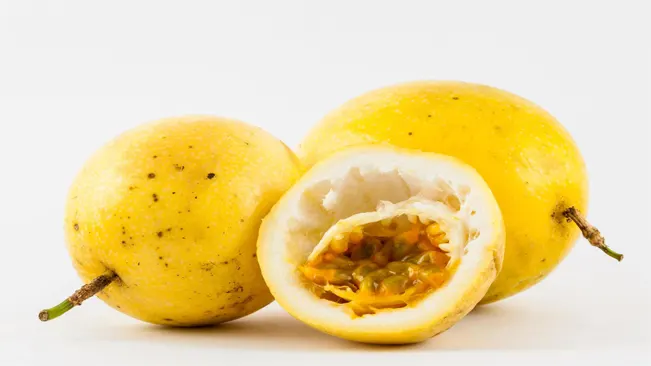
- Climate Suitability: Ideal for tropical climates. It thrives in warmer, more humid environments and is less tolerant of cold temperatures.
- Fruit Characteristics: The fruits are larger than the purple variety, with a bright yellow skin when ripe. They are less aromatic and have a slightly more acidic flavor.
- Growing Conditions: Prefers full sun and high temperatures. It needs well-drained, fertile soil and ample water.
- Usage: Commonly used in juice blends and for flavoring due to its slightly acidic, tangy taste. Also used in desserts, but less frequently eaten fresh compared to the purple variety.
Site Selection and Soil Preparation
Site Selection
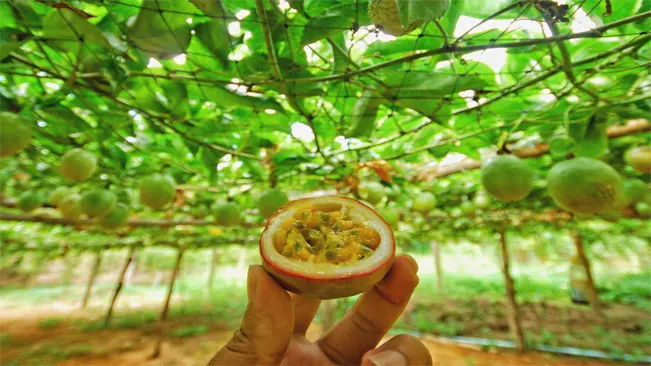
- Sunlight Requirements: Passion fruit vines are sun-loving plants. They require a minimum of six hours of direct sunlight per day to thrive. This sunlight is crucial for the development of flowers and fruits. Inadequate sunlight can lead to poor flowering and fruit set.
- Drainage and Location: It’s vital to choose a location with excellent drainage. Passion fruit vines are susceptible to root diseases, especially root rot, in waterlogged conditions. Elevated spots, gentle slopes, or raised beds can ensure better drainage. Avoid low-lying areas where water tends to accumulate.
- Microclimate Considerations: If you live in an area with strong winds, it’s advisable to select a site that offers some protection, as the vines can be damaged by extreme wind. Similarly, in colder regions, a wall or fence that radiates heat can provide a microclimate that is a few degrees warmer, helping the vine during cooler temperatures.
Soil Preparation
- Soil Type: Ideal soil for passion fruit cultivation is rich and loamy. Loamy soil, being a mix of sand, silt, and clay, has good drainage and holds nutrients well, which is beneficial for the growth of the vines.
- Soil pH: Passion fruit prefers slightly acidic soil, with a pH range of 6.5 to 7.5. You can test your soil’s pH using a soil testing kit available at garden centers. If the soil is too alkaline, you can amend it with sulfur to lower the pH, or if it’s too acidic, lime can be added to raise the pH.
- Improving Soil Quality: If your soil is heavy or clayey, it’s important to amend it to improve drainage. You can incorporate organic matter like compost, aged manure, and sand. This addition not only improves drainage but also enhances the soil’s fertility.
- Soil Fertility: Passion fruit vines are heavy feeders and require fertile soil. Enriching the soil with compost or well-rotted manure provides the necessary nutrients for their growth and fruit production.
Support Structure
- Importance of Support: Passion fruit vines are vigorous climbers and need support for their tendrils to cling to. This support also helps in keeping the fruit and foliage off the ground, reducing the chances of disease and pest infestation.
- Types of Structures: A sturdy fence, trellis, or arbor can serve as an excellent support structure. The structure should be strong enough to support the weight of the vine when it is fully grown and laden with fruit.
- Design and Spacing: Ensure that the support structure allows for enough space between the vines for air circulation, which is crucial in preventing fungal diseases. The design should also facilitate easy access for pruning, harvesting, and maintenance activities.
Planting
Planting Timing
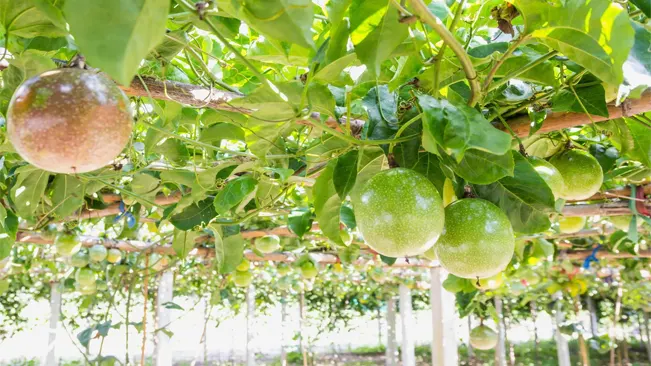
- Spring Planting: In areas with a distinct winter season, planting in spring allows the seedlings to establish themselves during the warmer months. The key is to wait until after the last frost, as passion fruit vines are sensitive to cold temperatures.
- Early Summer Planting: In cooler climates, early summer planting can be advantageous. This timing ensures that the soil has warmed up sufficiently, promoting better root growth and establishment.
Planting Method
- Hole Preparation: The hole should be prepared in a way that facilitates easy root expansion. Making the hole twice as wide as the root ball creates loose soil around the roots, allowing them to spread more easily.
- Planting Depth: It’s crucial to plant the vine at the same depth it was in the container. Planting too deep can stress the plant and slow its growth.
- Soil Considerations: Use a mix of garden soil and compost or well-rotted manure to fill the hole. This enriches the soil with nutrients and improves its structure.
- Watering After Planting: Thorough watering immediately after planting is essential. It helps settle the soil around the roots and eliminates air pockets, ensuring good root-to-soil contact.
Spacing
- Room for Growth: Passion fruit vines can grow quite large and require ample space to spread. Spacing them 10 to 15 feet apart ensures that each vine has enough room to grow without competing for nutrients and sunlight.
- Support Structures: Each vine will need a support structure. The spacing should take into account the room needed for trellises or other support systems.
- Air Circulation: Proper spacing also promotes good air circulation around each plant, which is important for reducing the risk of fungal diseases.
Watering and Fertilization
Watering Passion Fruit Vines
- Consistency is Key: Passion fruit vines require consistent watering to thrive, particularly during their flowering and fruit-setting stages. It’s important to establish a regular watering schedule.
- Soil Moisture: The goal is to keep the soil consistently moist. Check the top inch of the soil; if it feels dry, it’s time to water. Over-watering can be as detrimental as under-watering, leading to root rot.
- Deep Watering: Instead of shallow, frequent watering, opt for deep watering. This encourages the roots to grow deeper, making the plant more drought-tolerant and robust.
- Mulching: Applying mulch around the base of the vine can help retain soil moisture and regulate soil temperature, reducing the frequency of watering.
- Seasonal Adjustments: Be mindful of seasonal changes. Vines may require more water during hot, dry summers and less during cooler months.
Fertilizing Passion Fruit Vines
- Balanced Fertilizer: A balanced, slow-release fertilizer is ideal for passion fruit vines. Look for fertilizers with an equal ratio of nitrogen, phosphorus, and potassium (NPK), such as 10-10-10 or 20-20-20.
- Application Timing: Fertilize in the spring as the vine starts active growth, and again in summer to support fruit development. Avoid fertilizing in late fall or winter when the plant’s growth naturally slows.
- Organic Options: Incorporating aged manure or compost into the soil can be highly beneficial. These organic materials improve soil structure, add nutrients, and enhance the soil’s capacity to hold water and nutrients.
- Avoid Over-fertilization: Excessive fertilization can harm the plant, leading to leaf burn or excessive foliage growth at the expense of fruit production. Follow the recommended rates on the fertilizer package.
- Micro-nutrients: Occasionally, providing micro-nutrients like magnesium, calcium, and sulfur can be beneficial, especially if your soil lacks these elements.
- pH Considerations: Passion fruit vines prefer slightly acidic soil. If your soil is too alkaline, it can affect the plant’s ability to absorb nutrients. A soil test can help determine if pH adjustments are needed.
Pruning and Training
Training Passion Fruit Vines
- Initial Training: When your passion fruit plant is young, it’s crucial to train it to grow onto its support structure. This could be a fence, trellis, or any sturdy framework.
- Directing Growth: Gently tie the main stem of the vine to the support structure. As the plant grows, continue to tie new growth along the support to encourage vertical growth. This training helps the vine spread evenly and exposes more leaves to sunlight, which is vital for its health and fruiting.
- Encouraging Lateral Branches: Once the main stem reaches the top of the support structure, you can encourage it to grow laterally. This will increase the plant’s fruiting area.
Pruning Passion Fruit Vines
- Best Time to Prune: The ideal time for pruning is in early spring. This timing allows the plant to recover and grow vigorously during the growing season.
- Pruning Young Plants: In the first year, focus on creating a strong framework for the plant. Select a few healthy, strong branches to be the main fruiting arms and remove any weak or overcrowded growth.
- Maintaining Older Vines: In subsequent years, prune to remove dead or overgrown branches. This helps to rejuvenate the plant, encouraging new growth that will produce fruit.
- Thinning: It’s important to thin out some of the denser areas of the vine to allow light and air to penetrate. This practice helps in reducing the risk of diseases and improves fruit quality.
- Removing Old Wood: Passion fruit vines fruit best on new growth. Therefore, cutting back some of the old wood every year encourages the plant to produce new, fruit-bearing shoots.
- After Fruiting: Once the vine has finished fruiting, it’s a good time to do a more thorough prune to prepare the plant for the next season.
Benefits of Proper Pruning and Training
- Increased Fruit Production: Proper pruning and training maximize the fruit-bearing potential of the vine.
- Improved Plant Health: These practices enhance air circulation and light penetration, reducing the likelihood of disease.
- Easier Harvesting: Well-trained and pruned vines are easier to manage and harvest.
- Longevity of the Vine: Regular pruning and care can extend the life of your passion fruit vine, providing fruit for many years.
Harvesting
Passion fruit is ready to harvest when it changes color and falls off the vine. The fruit should feel heavy and full. Store at room temperature until they wrinkle slightly for the sweetest flavor.
Understanding the Right Time to Harvest
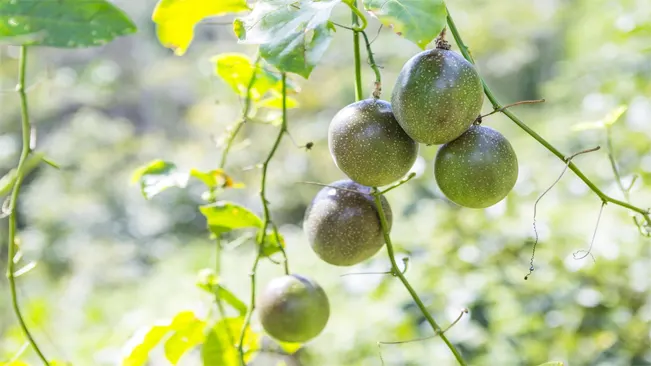
- Color Change: One of the primary indicators that passion fruit is ready to harvest is a change in color. For purple varieties, the skin turns from green to deep purple. Yellow varieties transition from green to a bright, vibrant yellow.
- Falling Off the Vine: Mature passion fruits often drop from the vine on their own. This natural drop is a clear signal that the fruits are ripe and ready for harvesting.
- Weight and Feel: Ripe passion fruits feel heavy for their size. When you hold a ripe fruit, it should feel dense and full, indicating that the inside is packed with juicy pulp.
Harvesting Technique
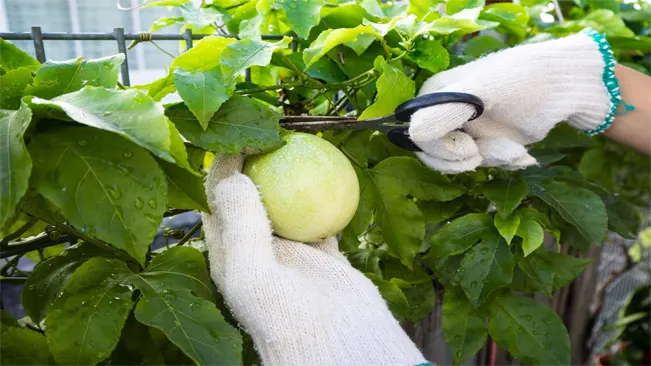
- Hand Picking: If the fruits haven’t fallen off naturally but exhibit other signs of ripeness (like color change and heaviness), you can gently twist and pull them off the vine.
- Using Pruners: For fruits that are slightly stubborn, use a pair of clean pruning shears to snip the fruit off, leaving a small stem attached.
Post-Harvest Handling
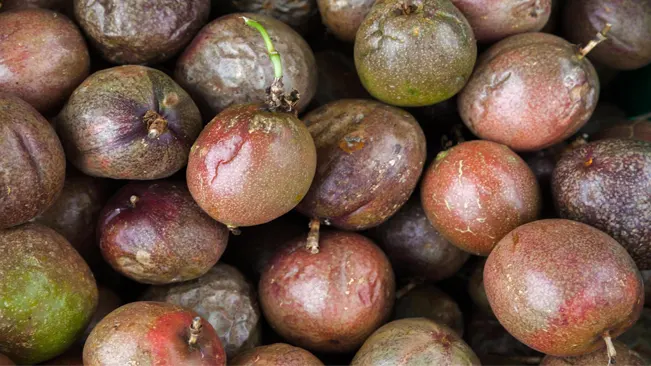
- Inspect the Fruits: Check for any signs of disease or pest damage. Healthy fruits should have a smooth, unblemished skin without any soft spots or cracks.
- Room Temperature Storage: Once harvested, store the passion fruits at room temperature. Avoid washing them until you’re ready to eat or use them, as moisture can promote decay.
- Wrinkling is a Good Sign: As the fruits start to wrinkle slightly, their sweetness and flavor intensity increase. This wrinkling process can take a few days to a week, depending on the initial ripeness and room temperature.
- Refrigeration for Longer Shelf Life: If you can’t use the passion fruits immediately, refrigerating them after they have wrinkled can extend their shelf life. They can be kept in the refrigerator for a few weeks.
Usage Tips
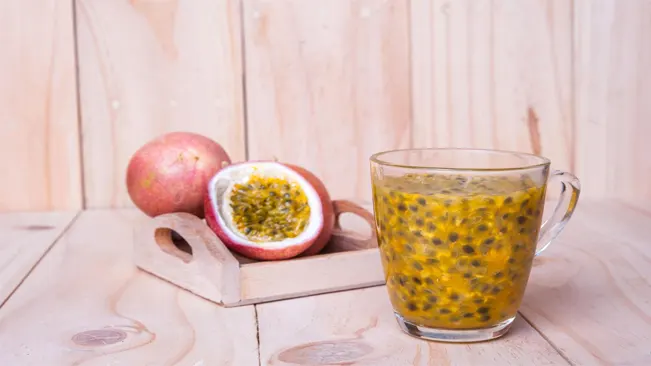
- Eating Fresh: Cut the fruit in half and scoop out the pulp and seeds. The pulp can be eaten directly or used in recipes.
- Juices and Smoothies: The pulp is excellent for making juices, smoothies, or flavoring yogurts and desserts.
- Cooking: Passion fruit can be used in various culinary preparations, including sauces, syrups, and baked goods.
Pest and Disease Management
Common pests include aphids, mites, and caterpillars. Diseases such as root rot and fungal infections can also occur. Use organic pesticides and fungicides, and practice good hygiene like removing fallen leaves and debris.
Pest Management
- Aphids:
- Description: Small, sap-sucking insects that can cause leaf curling and stunted growth.
- Management: Use a strong water spray to dislodge them, introduce natural predators like ladybugs, or apply organic insecticidal soap.
- Mites:
- Description: Tiny spider-like pests that can cause yellowing and speckling of leaves.
- Management: Increase humidity around the plant, use miticidal sprays, or introduce predatory mites as biological control.
- Caterpillars:
- Description: Larvae of butterflies and moths; they chew on leaves, leading to significant foliage damage.
- Management: Handpick them off the plants, use pheromone traps for moths and butterflies, or apply Bacillus thuringiensis (Bt), a natural bacterial toxin.
Disease Management
- Root Rot:
- Description: Caused by overwatering or poor drainage, leading to decay of the roots.
- Management: Ensure well-draining soil, reduce watering, and possibly apply fungicides. In severe cases, replant in fresh soil.
- Fungal Infections:
- Description: Includes diseases like anthracnose and powdery mildew, causing spots on leaves and fruit.
- Management: Apply organic fungicides, improve air circulation around the plant, and avoid overhead watering.
- Viral Diseases:
- Description: Diseases like passion fruit woodiness virus cause distorted leaves and fruits.
- Management: Remove and destroy infected plants, control aphid populations, and use virus-free planting material.
Conclusion
Growing passion fruit can be a rewarding experience. With proper care and maintenance, your vines will produce an abundance of flavorful fruit for years to come. Enjoy the fruits of your labor in juices, desserts, or simply fresh off the vine!
FAQs (Frequently Asked Questions)
- What climate is best for growing passion fruit?
Passion fruit thrives in tropical and subtropical climates. It prefers temperatures between 68°F and 82°F (20°C to 28°C) and is not frost-tolerant. - How do I prepare the soil for planting passion fruit?
The soil should be well-draining, rich, and slightly acidic (pH 6.5 to 7.5). You can improve soil quality by adding compost or well-rotted manure and ensuring good drainage. - How much sunlight does a passion fruit vine need?
Passion fruit vines need full sun, with at least six hours of direct sunlight daily. - Do passion fruit vines require a support structure?
Yes, they are climbing vines and need a strong support structure like a trellis, fence, or arbor to grow on. - When is the best time to plant passion fruit vines?
The ideal time to plant passion fruit is in the spring or early summer, after the last frost has passed in cooler climates. - How often should I water my passion fruit vine?
Regular watering is important, especially during flowering and fruiting. Keep the soil consistently moist but not waterlogged. Reducing water as the fruit begins to ripen can enhance flavor. - What type of fertilizer should I use for passion fruit vines?
Use a balanced, slow-release fertilizer in the growing season. Incorporating organic matter like compost or aged manure into the soil can also be beneficial. - How do I prune a passion fruit vine?
Prune in early spring to remove dead or overgrown branches and to shape the vine. Regular pruning encourages healthy growth and fruit production. - What are common pests and diseases that affect passion fruit vines?
Common pests include aphids, mites, and caterpillars. Diseases like root rot, fungal infections, and wilt can occur. Use appropriate organic pesticides and maintain good plant hygiene to manage these issues. - How do I know when passion fruit is ready to harvest?
Passion fruit is ready to harvest when it changes color and falls off the vine naturally. The fruit should feel heavy for its size. Allow it to ripen at room temperature for the best flavor.

Kristine Moore
Forestry AuthorI'm Kristine Moore, a seasoned garden landscaping professional with over 30 years of experience. My extensive career has been dedicated to transforming outdoor spaces into stunning, sustainable landscapes. With a deep understanding of horticulture, design principles, and environmental stewardship, I have become a respected figure in the field, known for creating harmonious, visually appealing, and eco-friendly gardens. My commitment to excellence and continuous learning in landscaping trends and techniques has solidified my reputation as an expert in garden design and implementation.




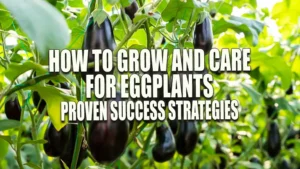


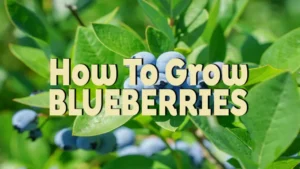


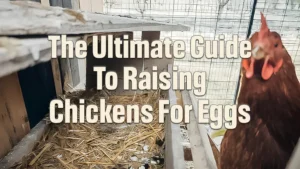
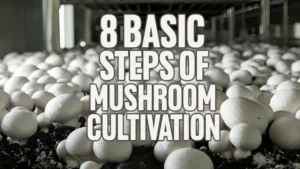

Leave your comment